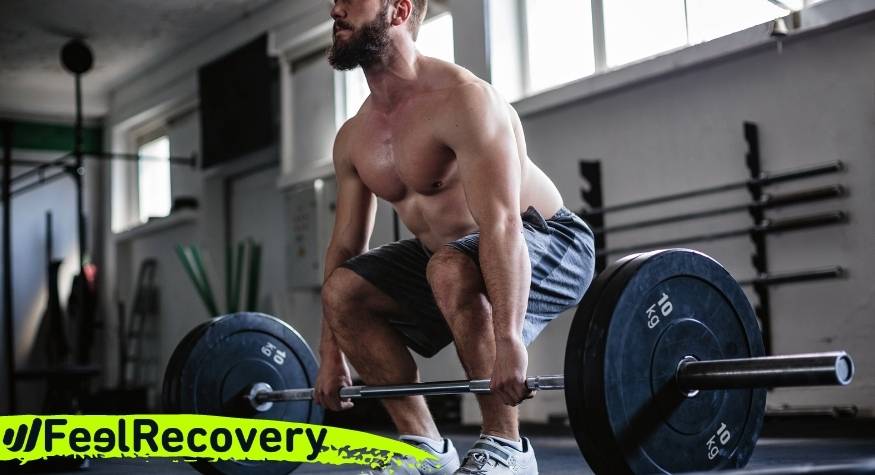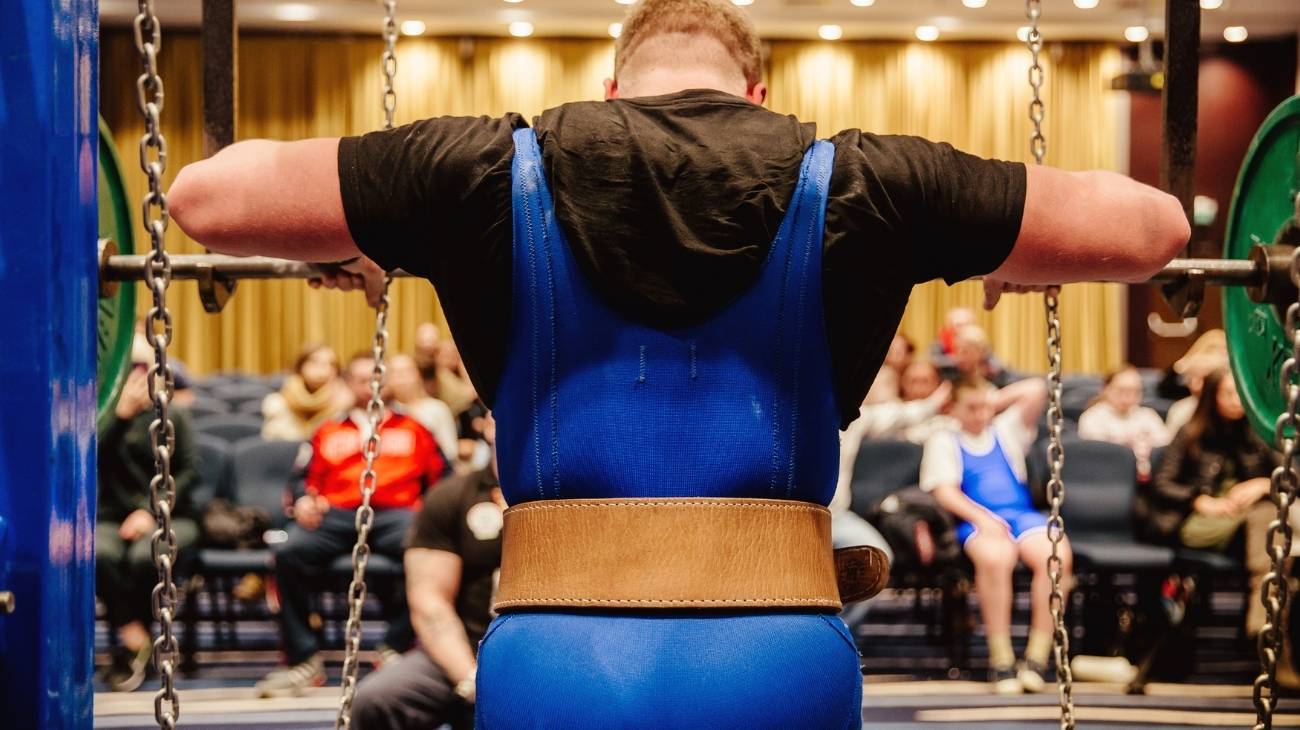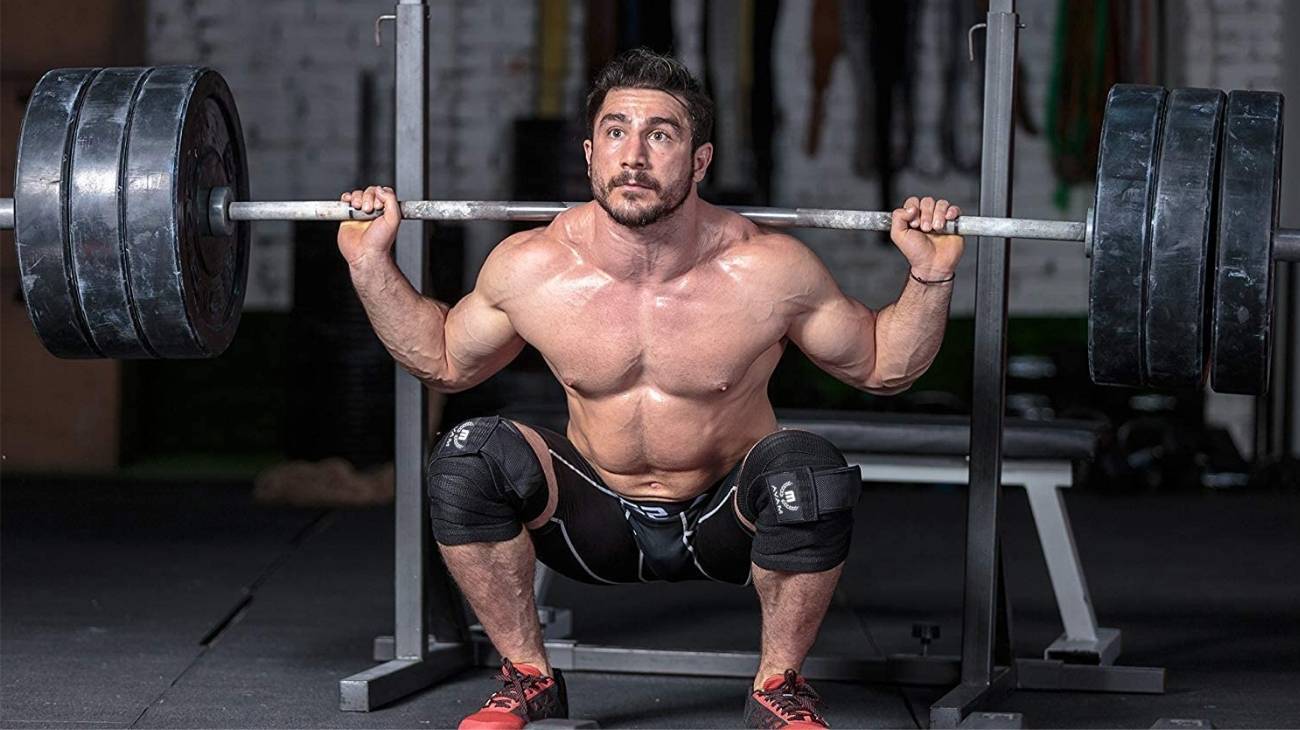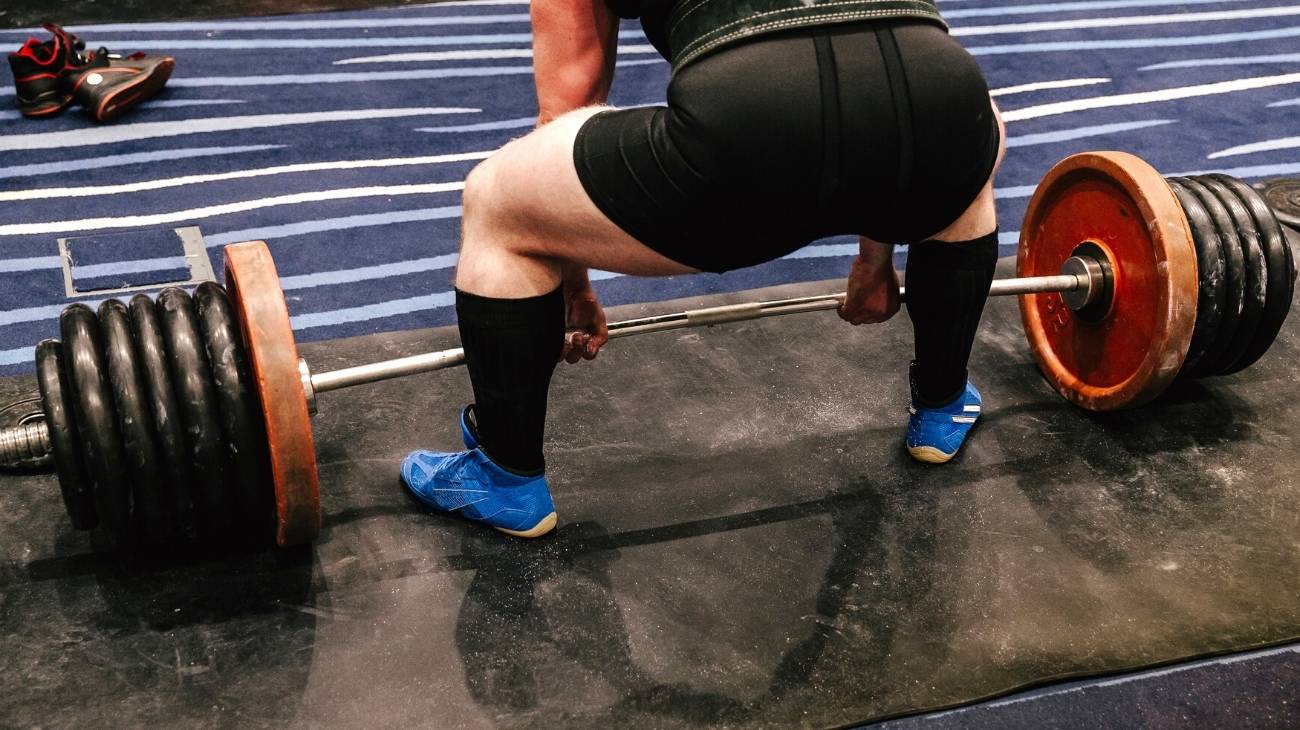Weightlifting is a pulling and pushing sport, so it is during the beginning of the lifting routine that there is the greatest risk of injury to the lower back, where most of the pain is concentrated.
When there is poor technique and lack of concentration, the likelihood of injury increases. We will show you the most common back problems when weightlifting. You will also learn how to apply the PRICE therapy when a soft tissue ailment occurs. Finally, you will learn about the products that facilitate recovery.
What are the most common types of back and lumbar injuries in weightlifting and powertlifting?
There's a reason why weightlifting requires the use of protective belts - if it weren't for them, the incidences in the sport would be higher. Take a look at this list of specific injuries to the lower back during weightlifting training or competitions.
Cervical spondylosis
Let's start with the upper back, in the cervical region where the spine meets the skull. This is a wear and tear on the discs in the spine that causes stiffness and pain in the neck and head. Irregular and sudden movements in lifting cause a kind of wh iplash that gradually causes significant wear and tear.
At the beginning there is not necessarily pain, it only appears when the vertebral wear and tear is more advanced. This pathology is common in people aged 50 and over, but the practice of weightlifting accelerates the damage until it causes cervical spondylosis.
Lumbar spondylolisthesis
Although it is likely to occur in the cervical spine, it is more common in the lumbar spine due to movements during weightlifting. It is an ailment of repetitive exercise that is made worse by applying too much weight to the body. It usually occurs in the L4, L5 and S1 sections of the spine and involves the displacement of one vertebra over another.
We speak of an anterolisthesis and retrolisthesis if the displacement is forwards or backwards respectively. When this injury occurs, the person registers pain in the legs if it is in the lumbar area, and in the arms when the displacement is in the cervical section. When walking, you will feel instability and intense pain.
Muscle contracture
The reason is simple; . In this modality there is no bar rest on the pectorals, the discs must pass from the floor to overhead in a single movement. The irregular bunching of the muscles prevents them from relaxing again, so they remain tense.
It is recommended that the body is well warmed up and the programmed exercises should be done up to five minutes before the first attempt. Repetitive, high repetitive strain will overload the muscles and cause them to suffer.
Disc wear and tear
This is a malady of experienced weightlifters who have had serious lower back injuries in the past. There is no way of knowing that a single injury causes it, it is simply a progressive wear and tear of the vertebral discs. When you feel constant pain, stiffness and difficulty standing upright or walking, it's a sign that you should lower the intensity and see a specialist to see what's going on with your back.
If the diagnosis is degenerative wear and tear, there will be few surgical options to keep you active in weightlifting as an amateur.
Muscle tear
A contracture is one thing, a tear or rupture of the muscle fibres that causes severe pain in the back is another. The damaged muscle becomes inflamed and heated to the point of requiring immediate application of the PRICE method.
A pull, as it is also known, occurs when the muscle is overstretched by the physical activity involved in weightlifting. A tear also occurs in the tendons, so it will be difficult at first to know what type of injury it is.
The paravertebral muscles are the ones that suffer the most, they are responsible for supporting the spine and support the entire body weight and the weight of the discs, which can exceed up to twice the athlete's build.
Iliac psoas injury
This is a muscle group that functions in hip flexion and extension. It is activated in the athlete's starting position, when the barbell lifting process begins. Remember that the knees are bent deep or at a 90° angle, in either case the back supports the whole body and contributes to the upward lunge of the bars.
Both are strong, and share a distal insertion at the lesser trochanter of the back. When there is an intention to exceed the weight to be lifted, it is likely that in the stride you will feel a pain in the lumbar area and this muscle group will become inflamed.
Lumbar sprain
In both twisting and pulling sports, lumbar sprain is common and involves the tearing of the tendons and muscles in the lumbar region as a whole. Having a badly tilted pelvis and old, poorly healed injuries will increase the likelihood of this injury, which requires complete rest and physiotherapy when it is time to return to training.
The paravertebral muscles must be well prepared, constantly warmed up before lifting, where most weightlifting injuries occur.
Best products for the recovery of back injuries in weightlifting and powerlifting
Bestseller
-
Acupressure Mat and Pillow (Black/Gray)
$49.95 -
Acupressure Mat and Pillow (Green/Navy)
$49.95 -
Acupressure Mat and Pillow (Pink/Bordeaux)
$49.95 -
Acupressure Pillow (Black/Gray)
$29.46 -
Acupressure Pillow (Green/Navy)
$29.46 -
Acupressure Pillow (Pink/Bordeaux)
$29.46 -
Back Support Belt (Black)
$34.95 -
Back Support Belt (Green)
$34.95 -
Back Support Belt (Pink)
$34.95 -
Heating Pad for Microwave Classic Bottle Shaped (Hearts)
$19.95 -
Heating Pad for Microwave Classic Bottle Shaped (Oxford)
$19.95 -
Heating Pad for Microwave Classic Bottle Shaped (Sport)
$19.95 -
High Density Foam Roller for Muscle (Black/Gray)
$29.95 -
High Density Foam Roller for Muscle (Green/Navy)
$29.95 -
High Density Foam Roller for Muscle (Pink/Bordeaux)
$29.95 -
Ice Massage Roller Ball (Black)
$39.95 -
Ice Massage Roller Ball (Green)
$39.95 -
Ice Massage Roller Ball (Pink)
$39.95 -
Microwave Heating Pad for Back Pain Relief (Extra Large) (Hearts)
$29.95 -
Microwave Heating Pad for Back Pain Relief (Extra Large) (Oxford)
$29.95 -
Microwave Heating Pad for Back Pain Relief (Extra Large) (Sport)
$29.95 -
Microwave Heating Pad for Neck & Shoulder Pain Relief (Hearts)
$24.95 -
Microwave Heating Pad for Neck & Shoulder Pain Relief (Oxford)
$24.95 -
Microwave Heating Pad for Neck & Shoulder Pain Relief (Sport)
$24.95 -
Microwaveable Heating Pad for Pain Relief (Hearts)
$19.95 -
Microwaveable Heating Pad for Pain Relief (Oxford)
$19.95 -
Microwaveable Heating Pad for Pain Relief (Sport)
$19.95 -
Pack 2 In 1 Foam Roller High + Soft Density (Black/Gray)
$29.95 -
Pack 2 In 1 Foam Roller High + Soft Density (Green/Navy)
$29.95 -
Pack 2 In 1 Foam Roller High + Soft Density (Pink/Bordeaux)
$29.95 -
Sacroiliac Support Belt (Black)
$24.95 -
Sacroiliac Support Belt (Green)
$24.95 -
Sacroiliac Support Belt (Pink)
$24.95 -
Soft Density Foam Roller for Recovery (Black)
$29.95 -
Soft Density Foam Roller for Recovery (Green)
$29.95 -
Soft Density Foam Roller for Recovery (Pink)
$29.95 -
Trigger Point Massage Stick (Black)
$14.95 -
Trigger Point Massage Stick (Green)
$14.95 -
Trigger Point Massage Stick (Pink)
$14.95
How to apply the RICE therapy to treat back injuries in weightlifting?
This method is a set of steps to follow to address minor injuries in the first few minutes. Remember to have ice and an elastic bandage at hand. These are the necessary supplies for a quick analgesic effect. PRICE is an update of the RICE therapy, as it was previously better known in the sporting world.
- Protection: Use a conventional bandage to cover the back injury. You should turn your back and abdomen all the way around, so that there are no more movements that could complicate the injury.
- Rest: You should take a rest from the presence of the injury. It is not a matter of doing nothing, what is sought is to minimise sudden and unexpected movements that will aggravate the damage to the soft tissues.
- Ice: This has an analgesic and anti-inflammatory effect. Ice can burn the skin if used directly, so it should be used with the support of a scarf or heat pack.
- Compression: Apply light pressure to the injury with an elastic bandage or back support. There are flexible straps that are made for this type of injury protection, if you have one it will work better than the bandage.
- Elevation: Make gravity an ally. Try lying down with a slight upward tilt of the lower back. It is a position that is recommended to maintain for 72 hours if you see improvement.
References
- Shimozaki, K., Nakase, J., Yoshioka, K., Takata, Y., Asai, K., Kitaoka, K., & Tsuchiya, H. (2018). Incidence rates and characteristics of abnormal lumbar findings and low back pain in child and adolescent weightlifter: A prospective three-year cohort study. PLoS One, 13(10), e0206125. https://journals.plos.org/plosone/article?id=10.1371/journal.pone.0206125
- Winwood, P. W., Hume, P. A., Cronin, J. B., & Keogh, J. W. (2014). Retrospective injury epidemiology of strongman athletes. The Journal of Strength & Conditioning Research, 28(1), 28-42. https://journals.lww.com/nsca-jscr/fulltext/2014/01000/Retrospective_Injury_Epidemiology_of_Strongman.5.aspx
- Aasa, U., Bengtsson, V., Berglund, L., & Öhberg, F. (2022). Variability of lumbar spinal alignment among power-and weightlifters during the deadlift and barbell back squat. Sports Biomechanics, 21(6), 701-717. https://www.tandfonline.com/doi/full/10.1080/14763141.2019.1675751
- Siewe, J., Marx, G., Knöll, P., Eysel, P., Zarghooni, K., Graf, M., ... & Michael, J. (2014). Injuries and overuse syndromes in competitive and elite bodybuilding. International journal of sports medicine, 35(11), 943-948. https://www.thieme-connect.com/products/ejournals/abstract/10.1055/s-0034-1367049
- Stone, M. H., Fry, A. C., Ritchie, M., Stoessel-Ross, L., & Marsit, J. L. (1994). Injury potential and safety aspects of weightlifting movements. Strength & Conditioning Journal, 16(3), 15-21. https://journals.lww.com/nsca-scj/Citation/1994/06000/Injury_Potential_and_Safety_Aspects_of.2.aspx/
- Aasa, U., Svartholm, I., Andersson, F., & Berglund, L. (2017). Injuries among weightlifters and powerlifters: a systematic review. British journal of sports medicine, 51(4), 211-219. https://bjsm.bmj.com/content/51/4/211.short
- Mazur, L. J., Yetman, R. J., & Risser, W. L. (1993). Weight-training injuries: common injuries and preventative methods. Sports Medicine, 16, 57-63. https://link.springer.com/article/10.2165/00007256-199316010-00005
- Keogh, J. W., & Winwood, P. W. (2017). The epidemiology of injuries across the weight-training sports. Sports medicine, 47(3), 479-501. https://link.springer.com/article/10.1007/s40279-016-0575-0
- Siewe, J., Rudat, J., Röllinghoff, M., Schlegel, U. J., Eysel, P., & Michael, J. P. (2011). Injuries and overuse syndromes in powerlifting. International journal of sports medicine, 32(09), 703-711. https://www.thieme-connect.com/products/ejournals/abstract/10.1055/s-0031-1277207
- Hamill, B. P. (1994). Relative safety of weightlifting and weight training. J Strength Cond Res, 8(1), 53-7. https://paulogentil.com/pdf/Relative%20Safety%20of%20Weightlifting%20and%20Weight%20Training.pdf
































































